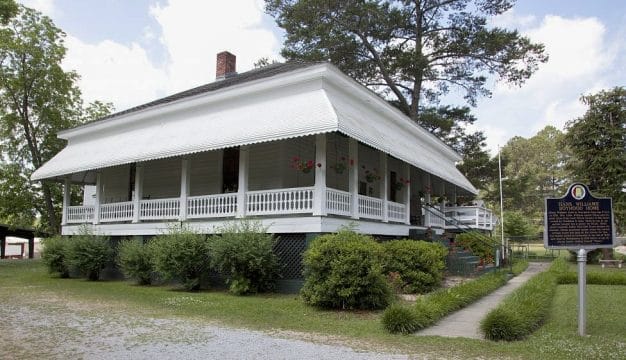Pecan Production in Alabama
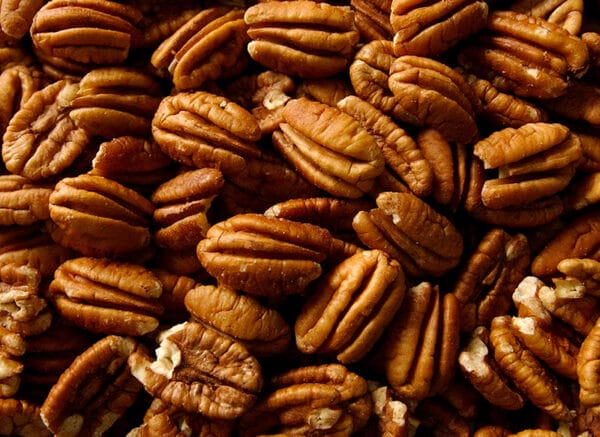 Pecans
Pecan nuts are produced on trees that are native to the United States. They have been grown commercially in Alabama since the early twentieth century. Alabama is one of 15 states that produces pecans commercially and has approximately 9,000 acres in 30 counties planted with pecan orchards, with the highest concentration in Baldwin and Mobile Counties. Between 2007 and 2017, Alabama growers produced about 49 million pounds of pecans. Beginning in 2019, pecan estimates were discontinued in Alabama. Alabama ranks eighth in pecan production in the United States and produces an average of about 5.4 million pounds of nuts a year. The United States produces an average of 238 million pounds per year.
Pecans
Pecan nuts are produced on trees that are native to the United States. They have been grown commercially in Alabama since the early twentieth century. Alabama is one of 15 states that produces pecans commercially and has approximately 9,000 acres in 30 counties planted with pecan orchards, with the highest concentration in Baldwin and Mobile Counties. Between 2007 and 2017, Alabama growers produced about 49 million pounds of pecans. Beginning in 2019, pecan estimates were discontinued in Alabama. Alabama ranks eighth in pecan production in the United States and produces an average of about 5.4 million pounds of nuts a year. The United States produces an average of 238 million pounds per year.
Pecan Biology
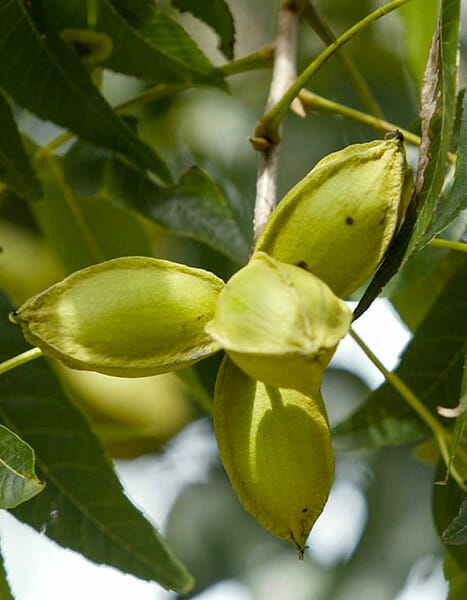 Pecan Cluster
The pecan (Carya illinoinensis) is a species of hickory in the walnut (Juglandaceae) family. The tree is native to the United States and Mexico and is the only commercial nut tree native to North America. Pecan trees are deciduous, shedding their leaves in the fall, and may grow between 70 and 100 feet tall. The trees have compound leaves that are between 12 and 18 inches long and are divided into between 9 and 15 long, pointed leaflets. Pecans are monoeciuos trees, meaning that they have both male and female flowers on the same tree. Male flowers appear on yellow-green slender stalks called catkins and produce pollen, which is spread by wind. Female flowers, which develop into nuts, are small and square and form in clusters of three to six at the tip end of the current season new growth. Because pecan trees have both male and female flowers on the same tree they can and often do self-pollinate. The release of pollen and the readiness of the female flowers to receive that pollen rarely happens at the same time on a single tree however. Therefore, nut experts usually recommend that growers plant two or more different varieties of trees within 150 feet of each other. Pecans vary in shape and size from small round nuts to large oblong nuts and may range anywhere from 20 to 100 unshelled nuts per pound.
Pecan Cluster
The pecan (Carya illinoinensis) is a species of hickory in the walnut (Juglandaceae) family. The tree is native to the United States and Mexico and is the only commercial nut tree native to North America. Pecan trees are deciduous, shedding their leaves in the fall, and may grow between 70 and 100 feet tall. The trees have compound leaves that are between 12 and 18 inches long and are divided into between 9 and 15 long, pointed leaflets. Pecans are monoeciuos trees, meaning that they have both male and female flowers on the same tree. Male flowers appear on yellow-green slender stalks called catkins and produce pollen, which is spread by wind. Female flowers, which develop into nuts, are small and square and form in clusters of three to six at the tip end of the current season new growth. Because pecan trees have both male and female flowers on the same tree they can and often do self-pollinate. The release of pollen and the readiness of the female flowers to receive that pollen rarely happens at the same time on a single tree however. Therefore, nut experts usually recommend that growers plant two or more different varieties of trees within 150 feet of each other. Pecans vary in shape and size from small round nuts to large oblong nuts and may range anywhere from 20 to 100 unshelled nuts per pound.
Pecan Culture
In Alabama’s humid climate, pecans suffer greatly from a destructive fungal disease called scab (Fusicladosporium caryigenum). Pecan scab is considered the most devastating and widely prevalent disease of pecans and many native hickories in the United States. The fungus primarily attacks the nut shuck, the green outer casing of a pecan, but can also infect leaves and stems. Severe infections can cause nuts to drop from the tree or fail to grow to their proper size. Affected nuts will usually have distinctive drab gray or black spots on the nut shuck, and in particularly severe cases, the entire shuck will be blackened. Scab is very costly to control with spraying. The development of resistant varieties such as Gafford, Amling, and Excel has greatly reduced losses from the disease. Other damaging diseases of pecans include downy spot, bacterial leaf scorch, and powdery mildew. All can cause premature defoliation, but damage from scab outweighs all the others combined.
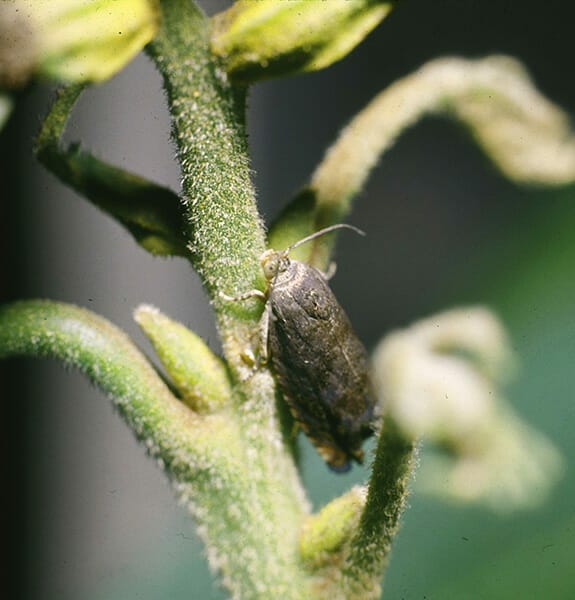 Hickory Shuckworm Moth
Many kinds of insect pests attack pecan trees. Among the most damaging pests are pecan weevils, hickory shuckworms, and aphids. Female pecan weevils lay their eggs inside the nuts, and when the eggs hatch, the larvae eat the kernels. Female hickory shuckworm moths deposit eggs on the outside of the pecan shuck, and within a few days larvae hatch from the eggs and burrow into the shuck. The larvae feed in the pecan shuck, disrupting the flow of nutrients to the developing kernel and reducing its quality. Yellow aphids are commonly found on the undersides of leaves throughout the growing season and are especially numerous from late August through early October. These pests excrete a sticky substance called honeydew onto the leaves. This honeydew later becomes covered in a black, sooty mold that limits the amount of sunlight reaching the leaflets, thus inhibiting photosynthesis, the chemical reaction that nourishes plants. Pecans require an average of 51 inches of water during the growing season, and drought can limit nut production. Pecan trees often need supplemental watering from May through October, with the month of September being especially critical because the kernels are filling out at this time. Lack of water in June and July typically results in small nuts, whereas similar conditions from late August through September result in poorly filled shells. Proper nutrition is equally important to the pecan tree. Nutrients commonly added through ground-applied fertilizers are nitrogen, potassium, phosphorus, zinc, calcium, magnesium, and sulfur. Several micronutrients, especially zinc, boron, nickel, and copper, are sprayed on leaves. Pecan growers typically test the soil and leaves each July to determine what nutrients the trees may need.
Hickory Shuckworm Moth
Many kinds of insect pests attack pecan trees. Among the most damaging pests are pecan weevils, hickory shuckworms, and aphids. Female pecan weevils lay their eggs inside the nuts, and when the eggs hatch, the larvae eat the kernels. Female hickory shuckworm moths deposit eggs on the outside of the pecan shuck, and within a few days larvae hatch from the eggs and burrow into the shuck. The larvae feed in the pecan shuck, disrupting the flow of nutrients to the developing kernel and reducing its quality. Yellow aphids are commonly found on the undersides of leaves throughout the growing season and are especially numerous from late August through early October. These pests excrete a sticky substance called honeydew onto the leaves. This honeydew later becomes covered in a black, sooty mold that limits the amount of sunlight reaching the leaflets, thus inhibiting photosynthesis, the chemical reaction that nourishes plants. Pecans require an average of 51 inches of water during the growing season, and drought can limit nut production. Pecan trees often need supplemental watering from May through October, with the month of September being especially critical because the kernels are filling out at this time. Lack of water in June and July typically results in small nuts, whereas similar conditions from late August through September result in poorly filled shells. Proper nutrition is equally important to the pecan tree. Nutrients commonly added through ground-applied fertilizers are nitrogen, potassium, phosphorus, zinc, calcium, magnesium, and sulfur. Several micronutrients, especially zinc, boron, nickel, and copper, are sprayed on leaves. Pecan growers typically test the soil and leaves each July to determine what nutrients the trees may need.
 Pecan Processing Facility
Pecans in commercial orchards are harvested mechanically. Mechanical harvesting involves machines called a tree shaker, nut sweeper, vacuum harvester, and trash separator. After pecans are harvested, they are dried quickly to maintain the quality of the nut by reducing kernel moisture. They are then placed in large drying trailers that are hooked up to large fans that force warm dry air up through the trailer. After drying, some pecans are sold immediately. The majority of pecans, however, are placed in refrigerated warehouses until sold. Homeowners can replicate this process by letting nuts air dry for a few days before placing them in sealed plastic bags and placing them in the freezer. Pecans can be kept in the freezer for up to two years or in a refrigerator for nine months.
Pecan Processing Facility
Pecans in commercial orchards are harvested mechanically. Mechanical harvesting involves machines called a tree shaker, nut sweeper, vacuum harvester, and trash separator. After pecans are harvested, they are dried quickly to maintain the quality of the nut by reducing kernel moisture. They are then placed in large drying trailers that are hooked up to large fans that force warm dry air up through the trailer. After drying, some pecans are sold immediately. The majority of pecans, however, are placed in refrigerated warehouses until sold. Homeowners can replicate this process by letting nuts air dry for a few days before placing them in sealed plastic bags and placing them in the freezer. Pecans can be kept in the freezer for up to two years or in a refrigerator for nine months.
Pecan Production in Alabama
Commercial pecan culture began in Alabama in the early 1900s, in the southern half of the state, principally in Mobile and Baldwin counties. By the 1940s, pecan production became a significant industry. One of the first areas planted was near Loxley in Baldwin County and in Mobile County near Oceanside, Mississippi. J. E. “Abe” Robinson was considered by many to be the father of the pecan industry in the state. Early growers planted the Stuart, Schley, and Success varieties. During the 1960s and 1970s, growers started planting varieties such as Desirable, Cape Fear, and Elliott. Today, most growers plant varieties such as Gafford, Amling, Excel, McMillan, Caddo, Forkert, and Surprize, which are known for their hardiness and productivity.
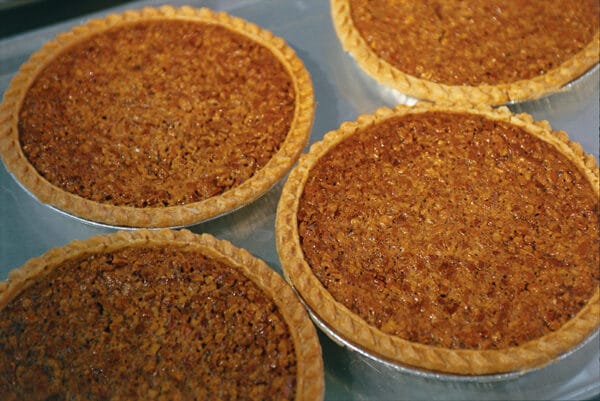 Pecan Pie
The nut’s popularity has risen over the past several years because nutrition researchers have discovered the health benefits of pecans and other nuts. In 2001, researchers at Loma Linda University in Loma Linda, California, found that supplementing a low-fat, cholesterol-lowering diet with pecans and other nuts each day lowered total cholesterol, low-density lipoproteins, and triglyceride levels, while maintaining high-density lipoprotein levels, thus helping reduce the risk of heart disease. Pecans are used in many ways. When most people think of pecans, they think of pies, and indeed this is a popular use of them. Pecans are used for candies, cookies, pies, and ice cream, on the sweet side. But on the savory side, pecans can be roasted, salted, and added to many meat dishes for extra flavor. Pecans can also be processed into an oil, similar to olive oil, for cooking. Pecan oil has less saturated fat than olive oil.
Pecan Pie
The nut’s popularity has risen over the past several years because nutrition researchers have discovered the health benefits of pecans and other nuts. In 2001, researchers at Loma Linda University in Loma Linda, California, found that supplementing a low-fat, cholesterol-lowering diet with pecans and other nuts each day lowered total cholesterol, low-density lipoproteins, and triglyceride levels, while maintaining high-density lipoprotein levels, thus helping reduce the risk of heart disease. Pecans are used in many ways. When most people think of pecans, they think of pies, and indeed this is a popular use of them. Pecans are used for candies, cookies, pies, and ice cream, on the sweet side. But on the savory side, pecans can be roasted, salted, and added to many meat dishes for extra flavor. Pecans can also be processed into an oil, similar to olive oil, for cooking. Pecan oil has less saturated fat than olive oil.
Many pecan orchards are located on small family farms. Growers produce their own pecans and sell them in retail shops right next to their orchards. The larger growers market their pecans to wholesalers, who in turn sell to different markets. Recently, growers have begun to develop overseas markets for U.S. pecans.
In the early 1960s, a small group of growers from Mobile and Baldwin counties formed the Southwest Alabama Pecan Association. In 1980, the association’s name was changed to Alabama Pecan Growers Association so it could be reconized as a state organization.
